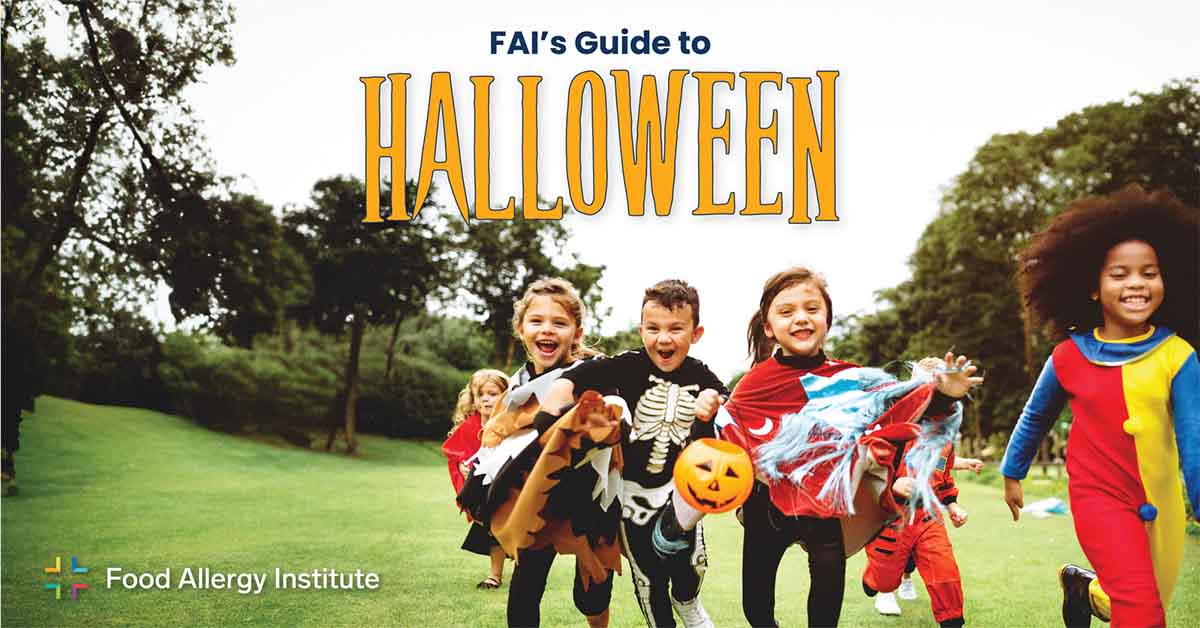
Halloween is a time of magic, fun, and treats for kids. But for families dealing with food allergies, it can feel like navigating a minefield of hidden dangers. At Food Allergy Institute, we understand the anxiety that comes with managing food allergies, especially during holidays like Halloween. However, with the right tools and some preparation, your family can enjoy a safe and festive experience.
Whether you’re looking for practical safety tips or a future where food allergies no longer stand in the way of your child’s joy, we’re here to help. Let’s make this Halloween about celebration, not fear!
Common allergens in Halloween treats often include peanuts, tree nuts, dairy, wheat, soy, and eggs. These allergens can be hidden in candies and snacks, posing significant risks for children with food sensitivities. Preparing your child for trick-or-treating is essential to ensure their safety.
That’s why you should choose to make Halloween both fun and safe by following these simple, effective tips…
Don’t Forget the EpiPen
While planning a fun Halloween night, always bring your child’s EpiPen or other prescribed medications. Allergens can sometimes be hidden or accidentally consumed, so it’s crucial to be prepared in case of an emergency. Make sure any supervising adults, such as family friends or neighbors, are aware of how to use the EpiPen and recognize the signs of an allergic reaction.
Plan Safe Routes
Identifying the right neighborhoods is key to a safe and enjoyable Halloween for children with allergies. Many communities share resources through apps like Nextdoor or social media groups where you can find maps or lists of homes offering non-food treats. Consider coordinating with other parents to share tips about which neighborhoods or specific houses to visit. If you’re new to the area, reach out to local allergy support groups for recommendations. By planning your route in advance, you can avoid last-minute stress and ensure a fun night for everyone.
Support the Teal Pumpkin Project
The Teal Pumpkin Project is an essential initiative that promotes allergy awareness by encouraging households to offer non-food treats, such as small toys or stickers, instead of traditional candy. Homes participating in the project display a teal pumpkin, signaling a safe stop for kids with allergies. To boost participation, share information about the project on local social media platforms, community boards, or neighborhood newsletters. You can even provide flyers or teal pumpkin stencils to neighbors who want to join in. The more awareness you raise, the safer and more inclusive your neighborhood will be.
Check Labels Before Eating
It’s important to remember that even familiar candy brands can alter ingredients or processing methods, especially with seasonal packaging. Before letting kids dig into their stash, set aside time to carefully inspect each label for allergens like peanuts, tree nuts, dairy, soy, egg, and wheat. Teach older children how to recognize key allergens on labels to help them make safe choices independently. Consider using SnackSafely Guides to check for potential allergens in popular candies. This habit not only ensures safety but also educates children about managing their allergies.
Pack Allergy-Friendly Treat Bags
Bringing your own allergy-friendly treats ensures your child can enjoy Halloween without feeling left out. Assemble personalized treat bags with safe snacks and fun non-food items like stickers, glow sticks, bubbles, or small toys. These can be handed out to your child during the evening to keep the experience exciting. You can also share these bags with friends or neighbors, showing them how easy it is to provide allergy-friendly options. This approach empowers your child, making them feel included without risking exposure to allergens.
Host Allergy-Safe Celebrations
Hosting your own allergy-safe Halloween event can be a great way to create a fun and controlled environment. Organize a costume parade, a pumpkin carving party, or a trunk-or-treat event with non-food activities. Consider partnering with local community centers, schools, or allergy support groups to expand the reach of these celebrations. Use decorations, music, and themed games to shift the focus away from food and onto fun.
Educating Friends And Neighbors About Food Allergies
Educating friends and neighbors about your child’s food allergies is an important step in ensuring a safe Halloween. Consider handing out allergy awareness cards that explain your child’s allergies and suggest safe treat options. This can help raise awareness and encourage others to be considerate when giving out treats. Moreover, you can invite your neighbors to join in on creating an allergy-friendly trick-or-treat option by suggesting non-food treats, like stickers or small toys. This way, your child can still enjoy the spirit of Halloween without the risk of allergic reactions.
These tips offer temporary peace of mind for Halloween but are not a lasting solution for food allergies. That’s why our Tolerance Induction Program™ (TIP) stands out, offering a comprehensive approach to achieving long-term food freedom.
Tolerance Induction Program™ (TIP): Don’t wait for an allergic reaction!
Food Allergy Institute’s Tolerance Induction Program™ (TIP) helps children and young adults with severe food allergies achieve “food freedom,” allowing them to fully participate in holidays and everyday life without having any allergic reactions.
TIP helps patients safely build tolerance to allergens using data-driven, personalized treatment plans. Patients build tolerance to allergens through biosimilar proteins before introducing their actual allergens. Biosimilar proteins are non-allergenic foods that have a similar molecular structure to a patient’s allergens. For example, a patient who is anaphylactic to peanuts may be tolerant to hazelnuts, a biosimilar protein.
TIP is the safest and most effective food allergy treatment, with epinephrine usage rates below 1%. It allows patients to build tolerance to multiple allergens at once, unlike other treatment programs that may only treat one allergen at a time. With a 99% success rate for those who complete treatment, TIP treatment typically lasts 2.5 to 4 years. By the end of treatment, patients can enjoy a life without allergy anxieties and food restrictions.
*Treatment duration varies by patient.
Watch the incredible testimonial of Evan, who is now in remission after completing the TIP program and will be celebrating his first fear-free Halloween:
With over 8,000 patients in food allergy remission through TIP, Food Allergy Institute is helping families take the fear out of food allergies—especially during Halloween.
Interested in learning more? Visit their website to explore how the Food Allergy Institute can help your family enjoy future Halloween with peace of mind.
About the Food Allergy Institute (FAI)
Founded in 2015 by Inderpal Randhawa, MD, the Food Allergy Institute is a cutting-edge clinical care and research center that is revolutionizing food allergy treatment. Built on over a decade of diagnostic data collected, Food Allergy Institute’s Tolerance Induction Program™ (TIP) is a specialized treatment program designed to help children with food allergies achieve “Food Freedom” — the ability to eat whatever they want, whenever they want, in unlimited quantities and without fear of reaction. Food Allergy Institute currently has locations in Long Beach and San Diego.


















